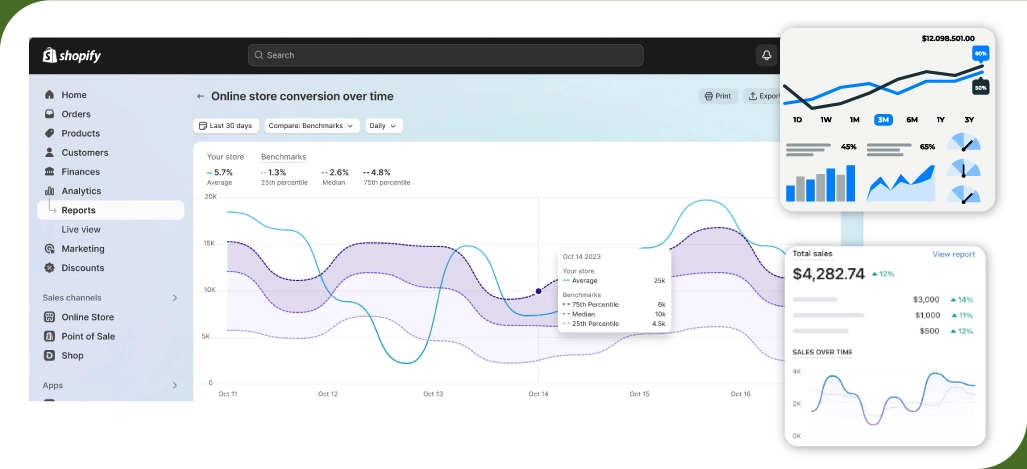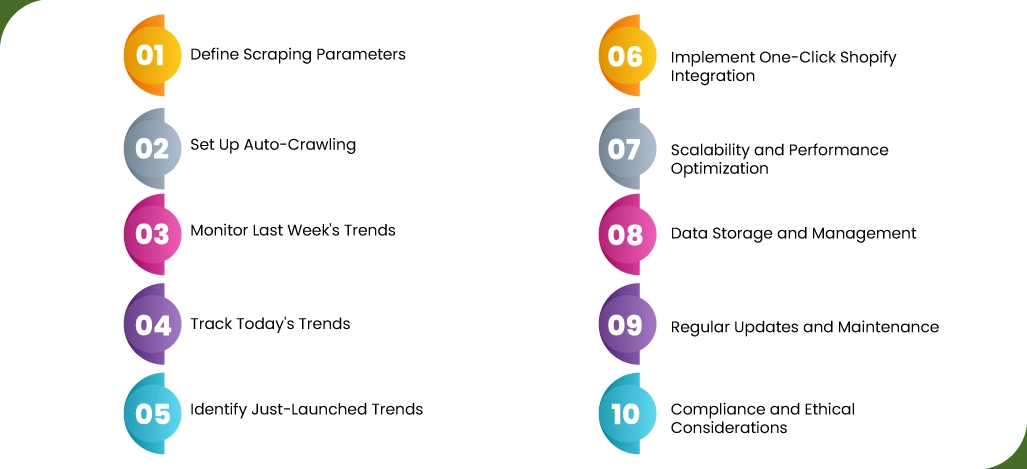
Introduction:
In today's data-centric landscape, deriving actionable insights from expansive datasets is crucial for businesses seeking a competitive advantage. Shopify stands out among the top e-commerce platforms, boasting numerous stores brimming with valuable data ripe for analysis. However, gathering data from many Shopify stores, particularly 150,000, can take time and effort. This comprehensive guide delves into diverse techniques and tools tailored to efficiently scrape and retrieve data from this vast array of stores.
Scraping 150,000 Shopify stores necessitates strategic planning and robust methodologies. Various approaches exist to streamline the data extraction process, from leveraging web scraping frameworks to employing APIs and automated scripts. Additionally, understanding the nuances of Shopify's structure and store interfaces is essential for effective scraping. With a focus on scalability and efficiency, this guide offers insights into managing the complexities inherent in large-scale data scraping endeavors.
Furthermore, considerations such as data privacy, ethical scraping practices, and compliance with terms of service are paramount. By adhering to best practices and employing appropriate tools, businesses can unlock valuable insights from Shopify's rich reservoir of data, empowering informed decision-making and driving competitive growth in the dynamic e-commerce landscape.
Understanding Shopify Store Structure:
Before embarking on web scraping Shopify stores data, it's vital to grasp their structure. Each store comprises product listings, categories, prices, descriptions, images, and customer reviews. Understanding these elements is pivotal for optimizing the scraping process and ensuring efficiency and accuracy in data extraction. Familiarity with Shopify's structure enables tailored scraping strategies, enhancing the retrieval of pertinent information while minimizing unnecessary data acquisition. By acknowledging these foundational aspects, web scraping endeavors can be executed more effectively, facilitating the extraction of valuable insights from Shopify's diverse stores.
Insights Offered by Scraping 150K Shopify Stores

Scraping data from 150,000 Shopify stores can yield insights across various dimensions of e-commerce and market dynamics. Here are some key insights that can be derived:
Product Trends and Popular Categories: By analyzing the types of products sold and their popularity across a large sample size, we can identify trends and determine which product categories are currently in demand.
Competitor Analysis: Scraping data from numerous Shopify stores allows for a comprehensive analysis of competitors' product offerings, pricing strategies, marketing tactics, and customer engagement techniques. It can help businesses benchmark their performance and identify areas for improvement.
Pricing and Discount Strategies: Examining pricing data from a large number of stores can provide insights into prevailing price points for various products and common discounting strategies employed by retailers. This information can inform pricing decisions and promotional activities.
Market Saturation and Niche Opportunities: By assessing the distribution of stores across different niches and geographic regions, we can gain insights into market saturation levels and identify underserved or emerging niche markets with growth potential.
Customer Preferences and Behavior: Analyzing customer reviews, ratings, and purchase patterns across a large dataset enables businesses to understand customer preferences, pain points, and buying behaviors. This information can guide product development, marketing campaigns, and customer service initiatives.
SEO and Website Optimization: Scrutinizing website structures, metadata, and content strategies across Shopify stores can reveal best practices for search engine optimization (SEO) and website optimization, helping businesses improve their online visibility and user experience.
Supply Chain and Inventory Management: Monitoring inventory levels, product availability, and shipping times across various stores provide insights into supply chain efficiency and inventory management practices. It can aid in optimizing inventory levels, reducing stockouts, and improving order fulfillment processes.
Brand Insights and Brand Loyalty: Studying brand presence, customer engagement metrics and brand loyalty indicators can offer insights into the effectiveness of branding strategies and customer retention efforts within the Shopify ecosystem.
Emerging Technologies and Innovations: Identifying the adoption of new technologies, payment methods, or business models within Shopify stores can signal emerging trends and innovations in e-commerce, enabling businesses to stay ahead of the curve.
Regulatory Compliance and Risk Management: Monitoring compliance with regulatory requirements, such as data privacy regulations or platform policies, can help businesses mitigate legal risks and ensure ethical practices.
Thus, scraping data from 150,000 Shopify stores can provide valuable insights into market trends, competitor dynamics, customer behavior, and operational practices, empowering businesses to make informed decisions and drive growth in e-commerce.
Choosing the Right Scraping Approach:
There are two primary approaches to scraping Shopify stores: API-based and web scraping.
API-based Scraping:
Shopify provides an API (Application Programming Interface) that allows developers to access and store data in a structured manner. You can fetch data such as product details, orders, customers, and more using the Shopify API. This approach is more reliable, efficient, and compliant with Shopify's terms of service.
Web Scraping:
Shopify stores data extraction involves collecting data directly from the HTML markup of Shopify store web pages. While this method provides more flexibility in data extraction, it's also more prone to breaking due to website layout changes and is often considered less reliable than API-based scraping. Additionally, web scraping may raise legal and ethical concerns, especially if not done responsibly.
Leveraging Shopify API for Data Extraction:
To scrape Shopify stores data using the API, you'll need to authenticate with the store using API keys. Once authenticated, you can make API calls to retrieve and store data based on your requirements. Standard API endpoints include fetching products, orders, customers, and collections. It's essential to handle API rate limits and pagination efficiently to avoid disruptions in data retrieval.
Implementing Web Scraping Techniques:
If API-based scraping is not feasible or sufficient for your needs, you can use web scraping. Popular web scraping tools such as BeautifulSoup (Python), Scrapy, or Puppeteer (JavaScript) can extract data from Shopify store web pages. However, it's crucial to respect robots.txt directives, avoid aggressive scraping, and handle dynamic content properly.
Data Storage and Management:
Once you've successfully scraped data from Shopify stores, storing and managing it is essential. Depending on the volume of data, you can choose suitable storage solutions such as relational databases, NoSQL databases, or cloud-based data warehouses. Organizing the data into structured formats will facilitate analysis and downstream processing.
Steps of Scraping 150,000 Shopify Stores

Scraping 150,000 Shopify stores with automated features involves several steps:
Define Scraping Parameters: Establish criteria for data extraction, including product details, store information, and trends.
Set Up Auto-Crawling: Implement scripts or bots to monitor and capture new stores, best sellers, new products, and trending items continuously.
Monitor Last Week's Trends: Utilize historical data to identify trends from the previous week, ensuring comprehensive insights into consumer preferences.
Track Today's Trends: Monitor real-time data to capture today's trending products and stay updated with current market demands.
Identify Just-Launched Trends: Detect recently launched products or stores gaining traction to capitalize on emerging opportunities.
Implement One-Click Shopify Integration: Develop a seamless integration feature allowing users to add desired products directly to their Shopify stores with a single click.
Scalability and Performance Optimization: Ensure the scraping system can handle the volume of 150,000 stores and over 50,000 products updated daily, optimizing performance and scalability for efficient data retrieval.
Data Storage and Management: Establish a robust data storage and management system using the Shopify Stores locator to organize and analyze the vast amount of scraped data effectively.
Regular Updates and Maintenance: Schedule regular updates and maintenance tasks to ensure the scraping system remains functional and up-to-date with the latest Shopify store data.
Compliance and Ethical Considerations: While conducting data scraping activities, adhere to legal and ethical guidelines and respect Shopify's terms of service and privacy policies.
By following these steps, businesses can effectively scrape data from many Shopify stores, staying abreast of market trends and gaining valuable insights for decision-making.
Conclusion: Scraping data from 150,000 Shopify stores unlocks a wealth of insights crucial for navigating the complexities of the e-commerce landscape. From discerning market trends to refining pricing strategies and understanding customer behavior, the depth and breadth of information obtained are unparalleled. This comprehensive analysis not only aids in staying ahead of competitors but also enables businesses to optimize operations, enhance customer experiences, and identify untapped opportunities. By harnessing the power of data from such a vast array of sources, businesses can make well-informed decisions that drive growth, innovation, and long-term success in the ever-evolving world of online retail.
Transform your retail operations with Retail Scrape Company's data-driven solutions. Harness real-time data scraping to understand consumer behavior, fine-tune pricing strategies, and outpace competitors. Our services offer comprehensive pricing optimization and strategic decision support. Elevate your business today and unlock maximum profitability. Reach out to us now to revolutionize your retail operations!
